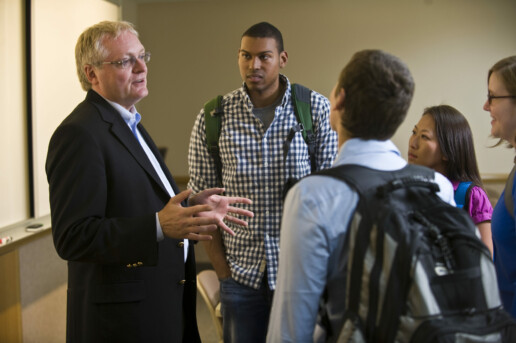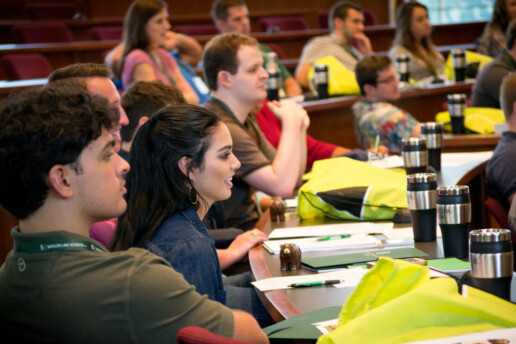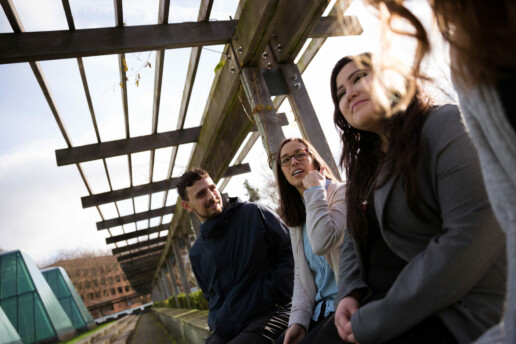How Many Law Students Are Following in Their Lawyer Parent’s Footsteps?
Why and how do people choose their course of study and their future career? While status, compensation, and personal values likely play an important role in choosing a career, there may also be an influence of family tradition. We used LSSSE data from 2019 and 2020 to ask how many law students have at least one lawyer parent and to see whether these students differ in appreciable ways from their classmates who were not raised by a lawyer.
Law students tend to have educated parents. Around 73% of LSSSE respondents have at least one parent with a bachelor’s degree or higher. One in five students (20%) have at least one parent with a doctoral or professional degree (PhD, JD, MD, DDS, etc.), and among those students, just over half (53%) report that the doctoral degree is a JD. Overall, 11% of LSSSE respondents have a parent with a JD.
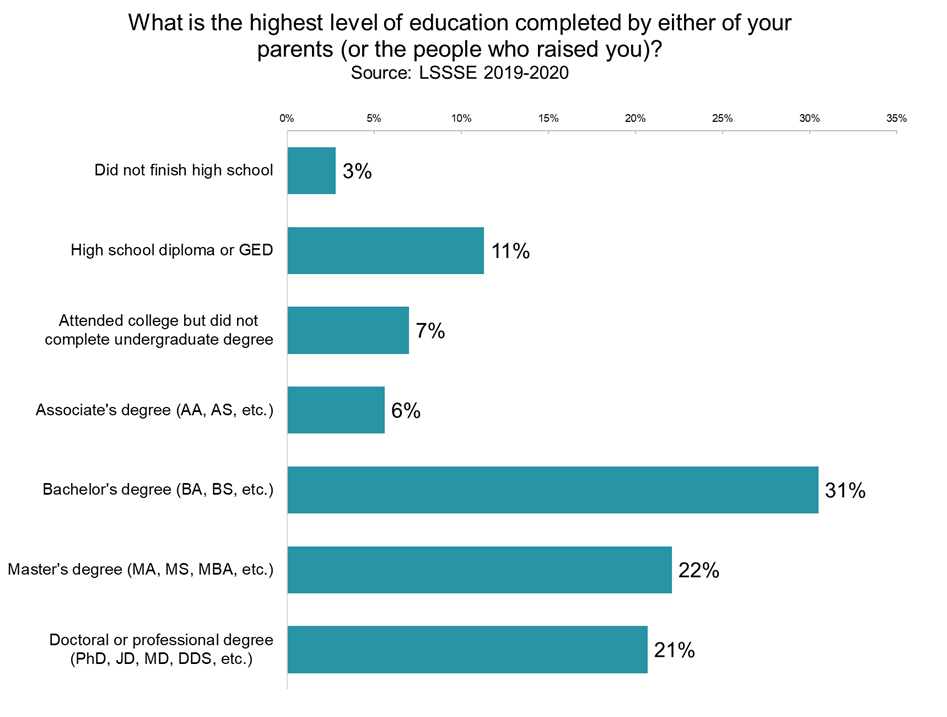
By and large, law students are satisfied with their experiences at law school, and we see minimal differences in satisfaction by parental education. If we combine “good” and “excellent” ratings, satisfaction is 84% among students who have at least one parent with a JD, 83% among students who have at least one parent with a different doctoral degree, and 81% among students whose parents do not have doctoral degrees. Students who have at least one parent with a doctoral degree may be slightly more likely to choose the highest rating (38% vs. 35% among students with non-doctorate parents).
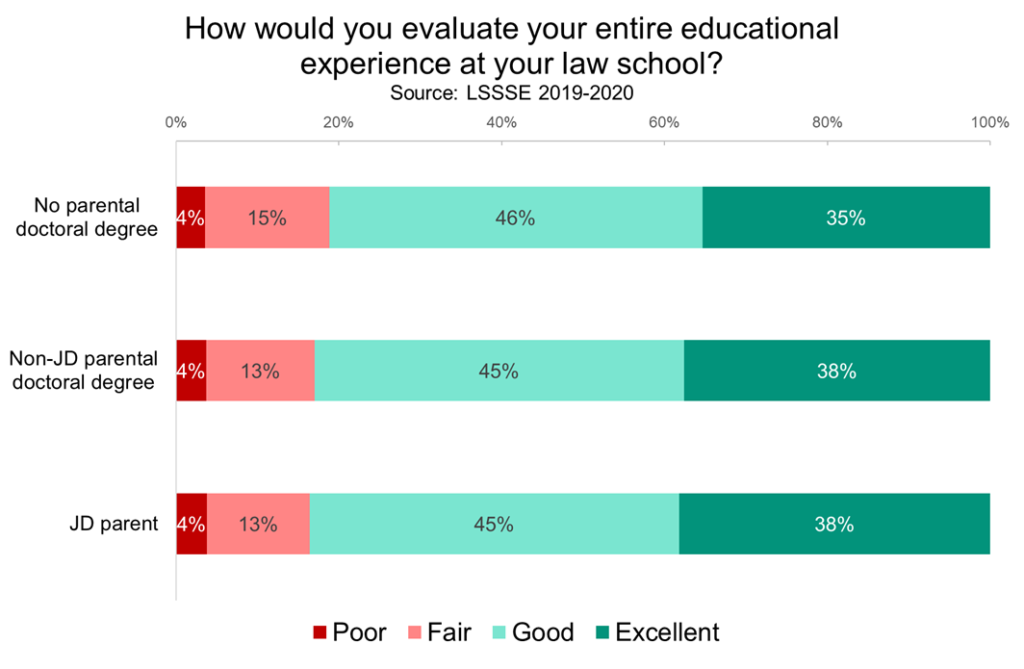
We do, however, see large differences in expected law school debt based on parental education. Students with less educated parents are much more likely to expect to owe more than $100,000 upon graduation and much less likely to graduate debt-free than their classmates with more educated parents. On some level, this may make sense, given that parental education is a strong predictor of a students’ socioeconomic status. However, it remains deeply problematic given that law school debt disadvantages students from lower income households and minimizes upward economic mobility, particularly among students of color. Interestingly, compared to their counterparts whose parents have non-JD doctoral degrees, students with JD parents are still less likely to owe over $100,000 and are more likely to graduate debt-free. If we assume socioeconomic status is roughly equivalent among parents with doctorates, then there may be some advantage to having a lawyer parent, either by increased parental investment in the students’ education or by a keener insight into navigating the process of financing a legal education.
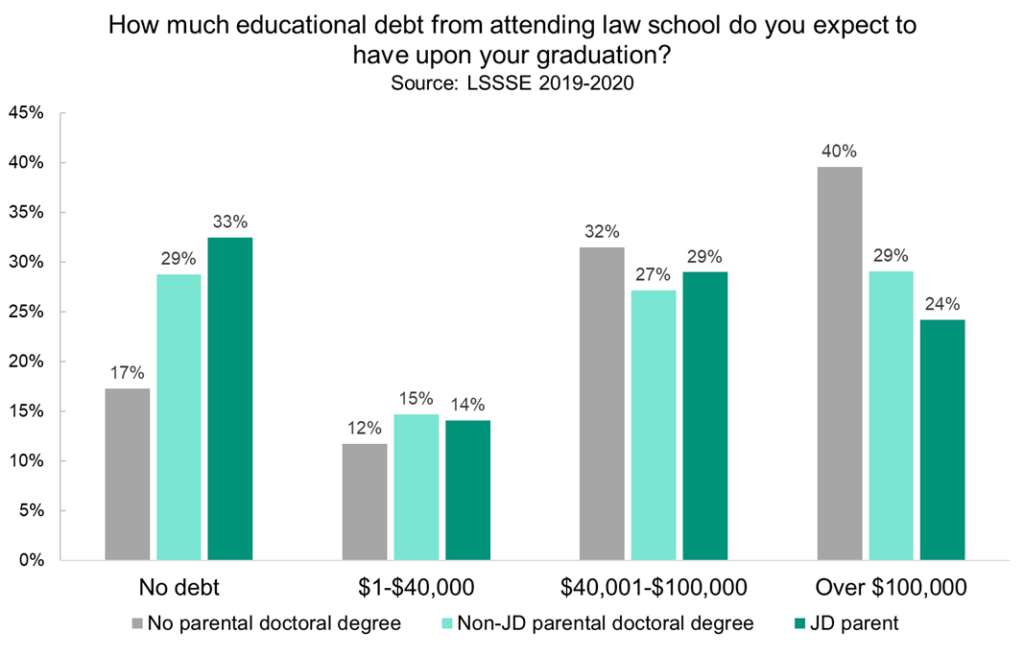
Guest Post: Legal Education and the Illusion of Inclusion
Guest Post: Legal Education and the Illusion of Inclusion
 Shaun Ossei-Owusu
Shaun Ossei-Owusu
Presidential Assistant Professor of Law
University of Pennsylvania Carey Law School
A new semester and a potentially new political landscape are upon us. Last month law students around the country resumed coursework. Their educational pursuits are virtual, in-person, or some mix of both. No matter the format, law students continue their educational journey in an ideologically polarized pandemic society where race, class, and gender disparities are on sharp display.
Students will also be learning in a context where changes in our legal system may have direct relevance to their legal education. As is typically the case, a newly constituted Supreme Court has a diverse docket this term that might shape substantive areas of law that students take courses in, chiefly constitutional law. There will be regulatory shifts that come with new administrations. These kinds of changes will have meaning for administrative law and related areas of law: health law, environmental law, employment law, and civil rights, to name a few. COVID-19 has upended state and federal judiciary systems in ways that have still-undetermined implications for procedural courses law students take (e.g., evidence, civil procedure, criminal procedure) and access to justice issues more generally. And we know from the late Deborah Rhode’s work which communities access to justice issues tend to devastate—racial minorities, women, and other marginalized populations.
Notwithstanding future uncertainty, one thing can be said with some measure of confidence: issues of race and gender—amongst other social categories—will remain relevant inside and outside the sometimes intellectually-cordoned off walls of law schools. How these issues are integrated in the classroom, if they are at all, will affect the substantive learning of law and will either include or exclude historically marginalized groups.
In the specific context of legal education, the results of Law School Survey of Student Engagement’s (LSSSE) Annual Survey illuminate. The Report provides a glimpse into how law schools fail to meet the aspirational goal of inclusion that often takes up primetime real estate on their websites and promotional materials. From my own read, the most jaw-dropping finding is intersectional in nature and about Black and Latinx women law students—aspiring attorneys who are often told that they do not look like lawyers when they transition to practice. 26% of Black women respondents and 17% of Latinx women respondents reported that their schools do “very little” to support racial and ethnic diversity.
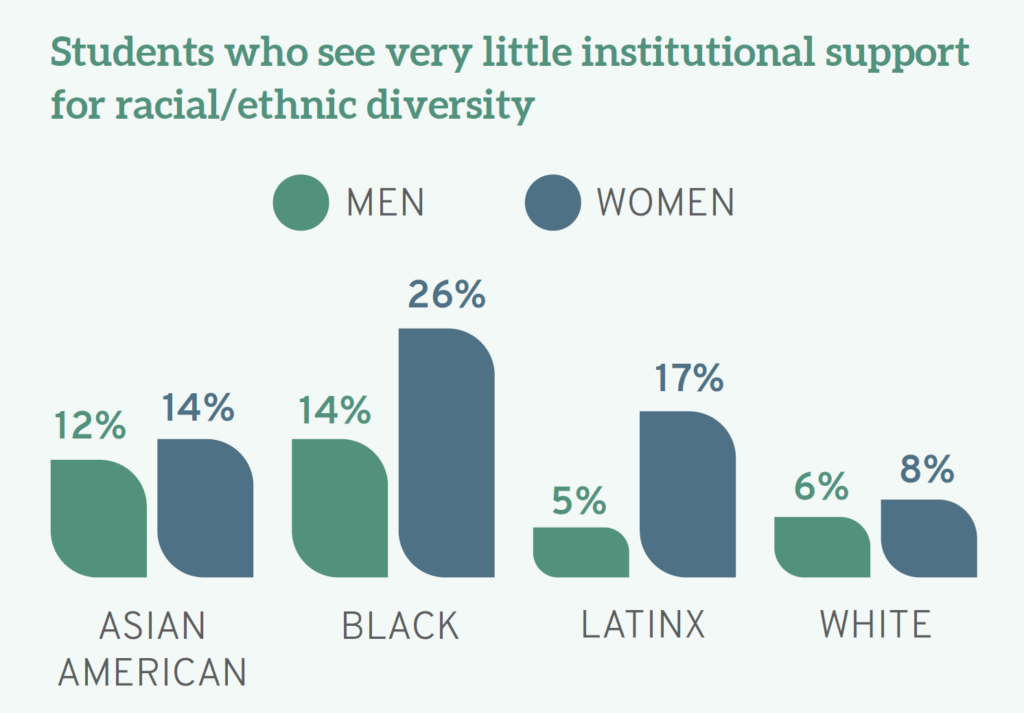
Disenchantment with the lack of support for diversity can be distilled even further. The Report notes that men varied on the issue of gender inclusivity, with 39% “very much” believing that their schools support gender diversity compared to 27% of women and 9% of individuals who identified with the “other gender” category.
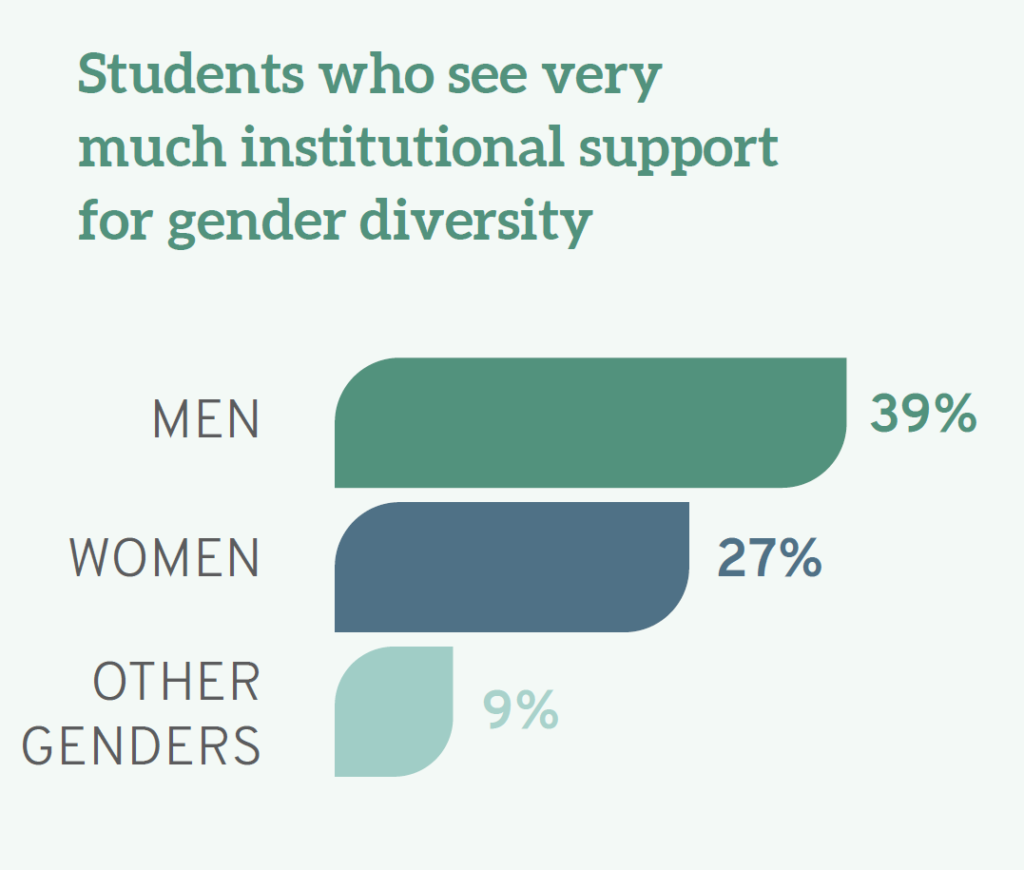
In the context of race, student views also differed, with 9% of White students, 14% of Native American students, 18% of Latinx students, and 25% of Black students believing that their schools do “very little” to ensure that students are not stigmatized based on identity.
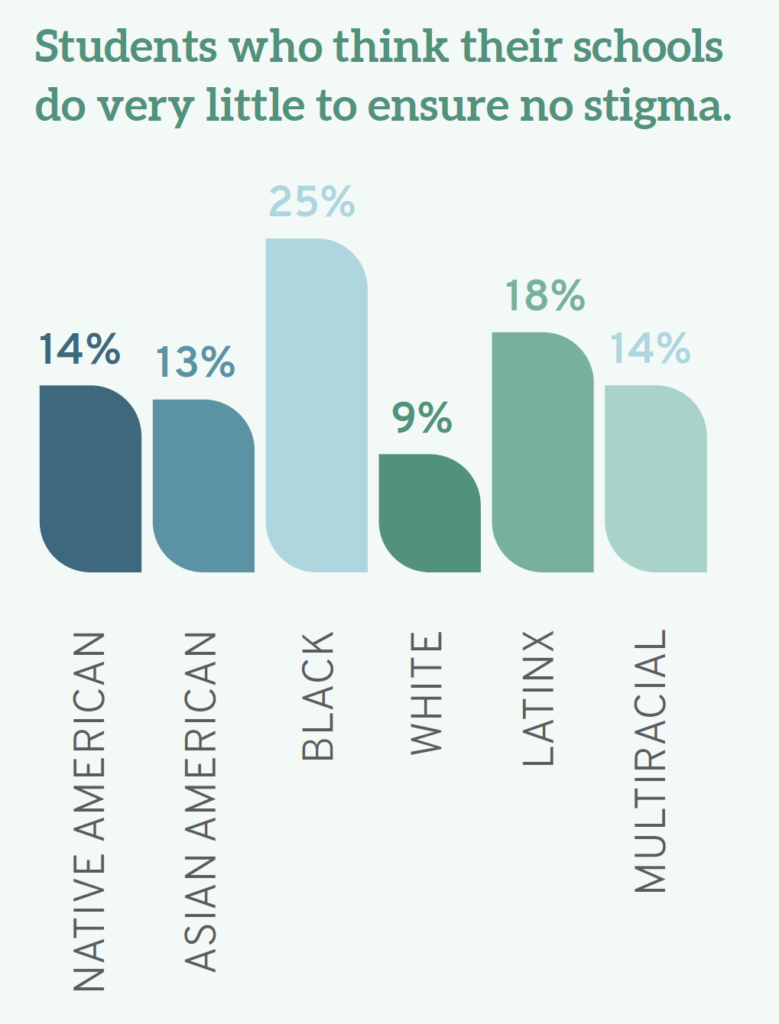
Where sexuality and sexual orientation are concerned, 11% of heterosexual students think their schools do only “very little” to avoid identity-based stigma; conversely, 20% of gay students, 16% of lesbian students, 15% of bisexual students, and 19% of those who identify as another sexual orientation see their schools as doing “very little” in this regard. What do these findings mean for legal education and the political moment I gestured to in the beginning?
LSSSE’s data suggest that some students are dissatisfied with the six-figure education they are receiving. Put plainly, law students from backgrounds that the profession has historically excluded—women, racial minorities, LGBTQ communities, and people with disabilities in particular—do not feel part of the academic community and believe law schools are relatively disinterested in their stigmatization. In some ways, this is unsurprising, as there is a deep scholarly literature and genre of books on student disappointment with law school. Moreover, student disenchantment with legal education—which has a history of exclusion that traces back to the nativism and anti-Semitism of the early twentieth century—may in some ways be pre-determined.
The confines of the classroom, which is one of the many areas the LSSSE survey discusses, provides more insight into the inclusion-exclusion dyad. From the vantage point of some educators, law school is simply about training people to be lawyers. The most generous reading of this position suggests that social justice-like ideas like “inclusion” are too ideologically weighty to meaningfully bring in the classroom. For people who subscribe to this view, attempts at inclusion can create impossible-to-navigate landmines for professors. More skeptically, some see inclusion as an ancillary. Read in this light, the primary goal is to inculcate legal knowledge. For these professors, some things are not relevant to the practice of law and are therefore not relevant to legal education.
Such professional school-based views of legal education, vary in their reasonableness, but are held by swaths of the professoriate. Yet, there is a two-fold problem, and this is where the LSSSE survey is especially useful. First, this vision of legal education rubs up quite abrasively against the representations of law schools as bastions of inclusion. Second, this version of education, in some ways, undermines the well-touted “diversity rationale” in affirmative action jurisprudence. What does diversity mean when the subjects of diversity feel alienated?
Considering the mismatch between some students’ experiences and the stricter professional school model of legal education that some professors are beholden to, there are some options. Educators can simply be more intellectually honest about the reality that law school is a site of professionalization where inclusion principles can be trivialized. Alternatively, law schools can continue to disingenuously hitch the law school wagon to social justice rhetoric while failing to actualize inclusion as a practice. Or, in the most courageous and imaginative versions of themselves, law schools can refashion their curriculum and use developments in the legal world as opportunities to offer more inclusive learning environments.
For law schools committed to the third way, resources abound. Complaints about the need to diversify the content of law school courses have existed for decades. Scholars such as Derrick Bell and Dorothy Brown have authored casebooks that describe how race intersects with different areas of the legal curriculum, whereas feminist legal theorists, poverty researchers, scholars of law and sexuality have penned their own books, supplements, and articles that all give educational guidance on how to bring these issues into core courses, and do so in ways that are doctrinally sound. Still, some professors—many of whom have the most analytically sharp minds on their university campuses—throw their hands up in despair or continue with the same regularly scheduled program. For some of these instructors, these conversations were absent in their legal education, and they were likely not trained to incorporate these issues. Some may think it would be better to leave this work of thematic inclusion to their more expert colleagues (e.g., scholars of race, sex, class, disability) rather than wade into territory where they are sure to mess up. But throwing one's hands up in despair is increasingly a less credible course of action. The pandemic, along with the protests of 2020, have forced some people to rethink how they deliver course content, and more importantly, have made inequality a more prominent theme in our public discourse. The current socio-political moment, and the reality of pandemic pedagogy, call for curricular redesign.
Fortunately, the tools to make the classroom more inclusive are available and they are not limited to the usual courses. To be sure, law professors have written about how first-year courses like criminal law and property are inattentive to inequality in ways that produce the responses found in the LSSSE survey and have offered suggestions on how those same courses could easily be improved. But attempts to diversify and create a more inclusive curriculum are not confined to these foreseeable areas of law but can be found in more unsuspecting places like evidence, corporate law, trust and estates, and intellectual property, to name a few.
Law professors have also identified space in the curriculum for trans-substantive engagement with the kinds of questions and perspectives that demonstrate an awareness of inequality, both in legal education and in law more generally. Indeed, I, along with my colleague Karen Tani, have taken on the task of trying to simultaneously create an inclusive learning environment that rigorously addresses inequality by creating a 50-person Law and Inequality course at Penn Law. This endeavor and more meaningful engagements with diversity need not be limited to women, racial minorities, and sexual minorities. Inclusion also implicates and has meaning for the larger law student population. One of the most understated findings in the LSSSE Report is that 16 percent of white students believed law schools placed “very little” emphasis on issues of equity and privilege and do not prioritize providing students with the skills necessary to confront discrimination and harassment.
My purpose here is not to proselytize teaching a course like the one we are offering. Instead, I want to highlight how student dissatisfaction with inclusion, which the Report highlights in detailed and accessible fashion, can be situated within this critical juncture. 2021 is a unique moment where law schools can reimagine legal education in real time, and for a post-pandemic world. This will not be easy, as this is a stressful time for faculty—some of whom are in high-risk groups during the pandemic and/or have a variety of care obligations. COVID-19 has upended a lot of assumptions and forced people to change longstanding pedagogical practices. Institutions could do a lot of good by encouraging faculty reflection and supporting creative reorganization of current courses.
The LSSSE Report tells us that in many ways, law schools are failing to provide the inclusive educational spaces that they, I believe in good faith, want to offer and that students of various backgrounds actively desire. Ultimately, the teaching tools are available, the moment is ripe, and the only outstanding question is whether legal educators will make the changes necessary so that the next LSSSE survey offers more optimistic findings.
What Do 1L Students Plan to Do in Law School?
Most students complete law school in three years. With intense coursework and notoriously challenging reading loads, law students must be selective about how they allocate their time toward extracurricular activities. Which enriching activities had 1L students completed or planned to complete before graduation in 2019 and 2020? Check out our interactive visualization below to see.
** Note that non-binary students are included only when the population was large enough to ensure student anonymity in aggregate reporting.
Annual Results 2020 Diversity & Exclusion: Diversity Skills
This year for the first time, LSSSE introduced a set of questions focused on diversity and inclusion that supplement related questions from the primary survey. The Diversity and Inclusiveness Module examines environments, processes, and activities that reflect the engagement and validation of cultural diversity and promote greater understanding of societal differences. The 2020 LSSSE Annual Results Diversity & Exclusion report presents data about how diversity in law school can prepare students for the effective practice of law upon graduation. In our final post in this series, we will explore how law schools can teach skills to equip students to interact with people from different backgrounds.
Schools have a responsibility to not only admit and provide the resources to enroll a diverse class of students, but to impart the skills these students will need to be effective lawyers. Increasingly, the practice of law requires sensitivity to issues of race/ethnicity, gender, sexual orientation, and socioeconomic status. Law schools can empower students first by encouraging them to reflect on their own identities, and then supplying coursework on issues of privilege, diversity, and equity; while it is important for students to learn about anti-discrimination and anti-harassment, law schools should also equip them with the tools they will need to fight these social problems as attorneys and civic leaders.
Yet schools are, by and large, not preparing law students to meet these challenges and succeed as leaders. When students were asked how frequently they reflect on their own cultural identity, only 12% of White students do so "very often," compared to 50% of Native American students, 44% of Black students, and 34% of Latinx students. Even more alarming, over a quarter (26%) of White students never reflect on their cultural identity during law school. When we consider the intersection of raceXgender, an even more troubling picture emerges. A full 28% of White men and 25% of White women in law school never reflect on their cultural identity, compared to the 50% of Black women who do so "very often."
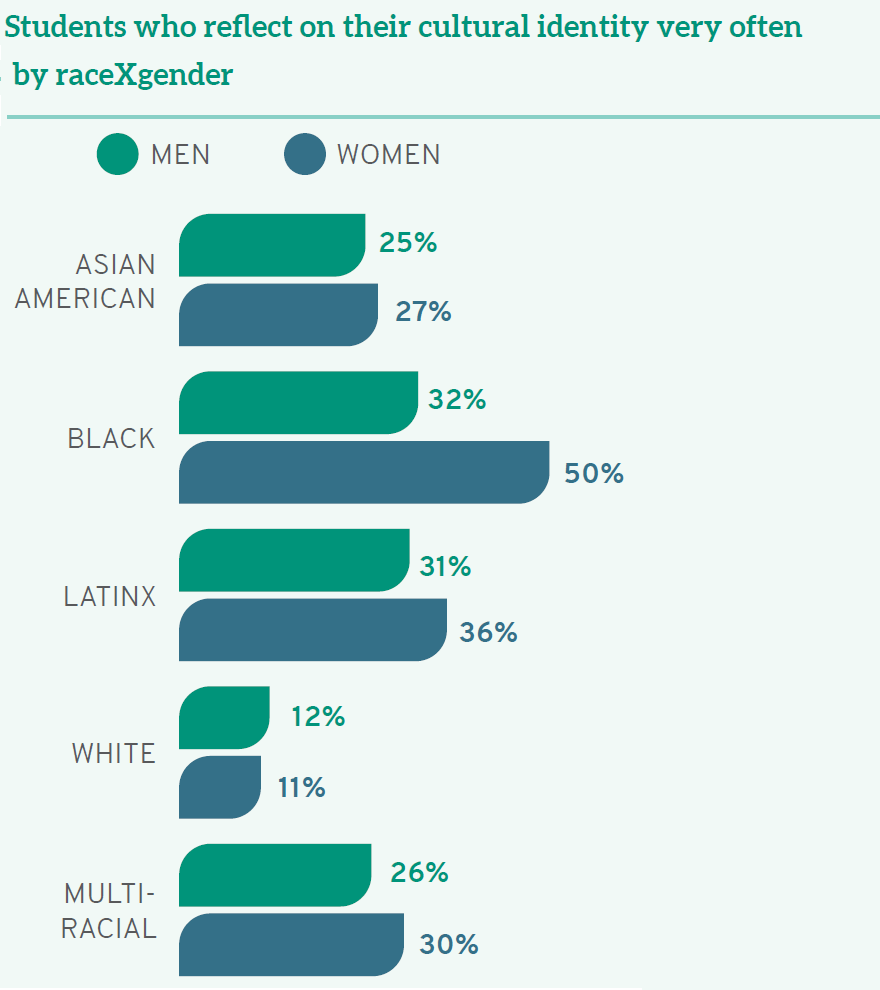
Students whose parents have less formal education are also more likely to reflect on their cultural identity, including 34% of those whose parents did not finish high school as compared to 16% of those who have a parent with a doctoral or professional degree. In sum, students with racial, gender, or class privilege are less likely to reflect on the benefits associated with their identity.
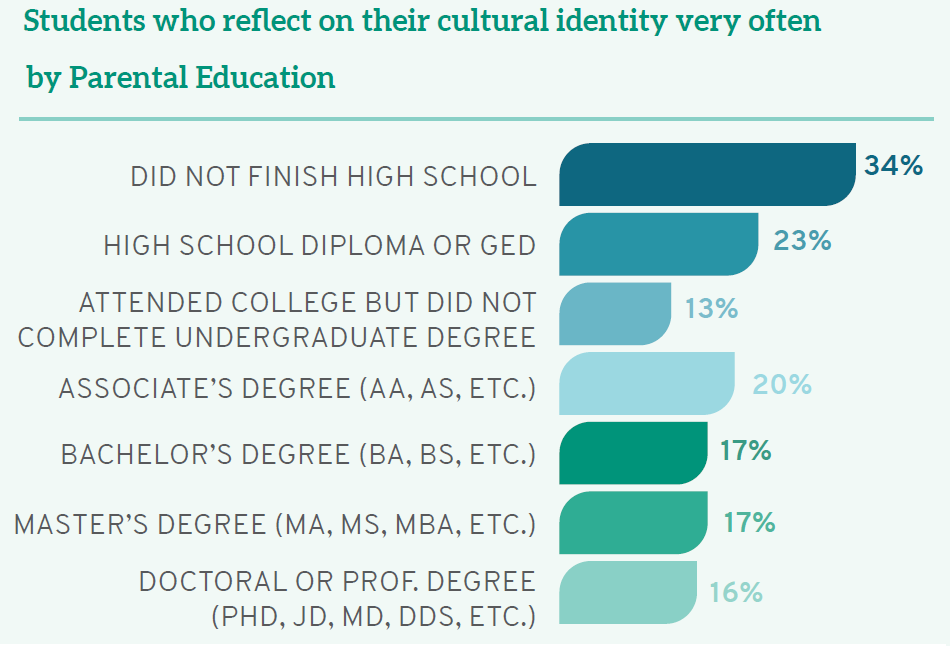
Even without self-reflection, students can nevertheless gather information about anti-discrimination and harassment policies. LSSSE data show that while White students see their schools as prioritizing this information, students of color do not agree at the same high levels. Similarly, men (31%) are more likely than women (23%) and those with another gender identity (11%) to believe their schools strongly emphasize information about anti-discrimination and harassment. Considering raceXgender, a full 27% of Black women see their schools as doing "very little" to share information on anti-discrimination and harassment, while 32% of White men believe their schools do "very much" in this regard.

Equally troubling, students from different backgrounds perceive institutional emphasis of various diversity-related topics in starkly divergent ways. Although White students believe that their schools emphasize issues of equity or privilege, respecting the expression of diverse ideas, and a broad commitment to diversity, students of color are less likely to agree. Students of color—including those who are Black, Latinx, Asian American, Native American, and multiracial—frequently note and appreciate assignments or discussions of race/ ethnicity and other identity-related topics in the classroom; yet they are more likely than their White peers to report that schools place “very little” emphasis on diversity issues. Women are similarly more likely than men to believe their schools do “very little” to emphasize diversity in coursework. Furthermore, higher percentages of Black women report “very little” emphasis on equity or privilege (36%), respecting diverse perspectives (27%), and an institutional commitment to diversity (21%)— compared to high percentages of White men who believe their schools are doing “very much” in all three arenas (20%, 24%, and 34%, respectively). First-gen students are also more likely than their classmates whose parents completed college to note “very little” diversity coursework. Synthesizing these data, students who are traditionally underrepresented and marginalized—arguably the students who have the most personal experience with issues of diversity—see their schools as doing less to promote diversity and inclusion than those who are privileged in terms of their race/ethnicity, gender, and parental education.

As part of a broad curriculum that sets up students for their future practice, law schools should teach students diversity skills—a set of skills that facilitate success in our increasingly globalized society, ranging from personal reflection to the tangible tools lawyers can use to combat discrimination. Law schools that succeed at these diversity-related endeavors will be preparing our nation’s newest lawyers to meet the full range of challenges ahead.
Guest Post: Connections and Community in Distanced Classrooms
Guest Post: Connections and Community in Distanced Classrooms
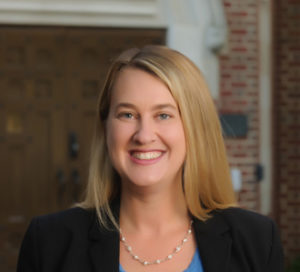 Jessica Erickson
Jessica Erickson
Professor & Associate Dean for Faculty Development
University of Richmond School of Law
Law faculty put significant thought into designing courses. We draft learning objectives, carefully craft assessments, and consider how to engage students inside and outside of the classroom. When law school courses suddenly moved online, many faculty had to think about a new aspect of course design how to build connections in classrooms where students were remote. Even in classes that were able to meet in-person, many of us found it difficult to develop a classroom community when students were in masks and seated six feet apart.
When we could no longer have casual conversations with students after class or in the hallways, many of us realized just how crucial these connections are for our students and for us. In this blog post, I discuss the importance of relationships to student learning and outcomes, as well as how to develop these relationships in online, hybrid, or physically distanced classes.
- The Importance of Relationships
Connections and community are essential to student learning. As I have previously discussed, research from undergraduate institutions shows that a sense of community is associated with increased motivation, greater enjoyment of classes, and more effective learning. Crucially, data from the Law Student Survey of Student Engagement (LSSSE) shows that these connections matter to law students as well. LSSSE data has been used to examine both the inputs and outputs of law students’ sense of belonging. Using LSSSE data, we can gain insight into what causes law students to feel a sense of belonging (inputs) and the impact that a sense of belonging has on law students’ performance in law school and their career (outputs).
Starting with inputs, LSSSE’s 2018 report Relationships Matter surveyed more than 18,000 students at 72 law schools. The report concludes: “Relationships with faculty, administrators, and peers are among the most influential aspects of the law student experience. These connections deepen students’ sense of belonging and enhance their understanding of class work and the profession.” Connections, in other words, are key when it comes to fostering law students’ sense of belonging. Law schools are doing a good job at developing connections, with 83% of students stating that they have at least one faculty member whom they could approach for advice or guidance.
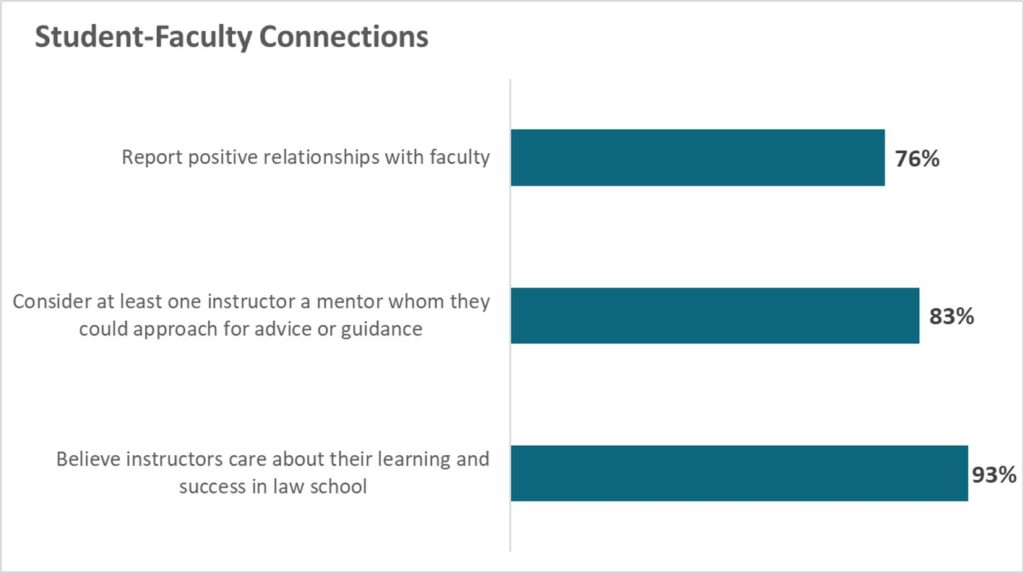
When it comes to outputs, we can look at research by Professor Victor D. Quintanilla using LSSSE data. He found that a sense of belonging significantly predicted three key outputs – (1) students’ overall experience in law school, (2) whether they would choose to go to law school again, and (3) their academic success (i.e., law school GPA). Moreover, not only does a student’s sense of belonging predict academic performance, but the impact was even greater than other commonly used predictors such as undergraduate GPA and LSAT scores. This means that, even if students come to law school with different academic backgrounds, we can help close this gap by fostering our students’ sense of belonging.
Unfortunately, the research also suggests that building this sense of community is much harder in online or hybrid courses, which most of us who taught this past fall can probably confirm. Now we need to think even more deliberately about how to develop these connections in our classes.
- Building Relationships in Remote or Physically Distanced Classrooms
This past summer, I wrote two blog posts, one with suggestions on how faculty can connect with students in these new learning environments and the other with suggestions on how faculty can help students connect with each other. In this post, I want to reflect back on these strategies now that I have tried many of them with my own students.
First, I found office hours to be a key way to connect with students. I renamed my office hours “student hours” on the advice of a colleague, and I borrowed language from this same colleague to include in my syllabus: “I call these ‘student hours’ for a reason: they are for you. You should come to these student hours if you have a question about the course, but you can also just stop by to introduce yourself, ask any other questions, or talk about your law school experience. I want to get to know you!” At the start of each meeting, I talked with students about how law school was going, and it was a great opportunity to get to know them better.
I call these ‘student hours’ for a reason: they are for you. You should come to these student hours if you have a question about the course, but you can also just stop by to introduce yourself, ask any other questions, or talk about your law school experience. I want to get to know you!
Second, I used technology to connect with students individually. I asked each of my students to create their own Google Doc and share it with me, and they were required to compete short pre-class assignments in their Google Docs. I’ve used this strategy in the past, and found it to be a great way to make sure that students understand the reading. This semester, though, I set aside 1-2 hours before each class to include personal comments on each students’ assignments. I had 52 students across two classes, so it took a while, but it allowed us to connect more personally. I also gave them “Just for Fun” optional questions to include in their Google Doc where they could tell me their favorite board game or share a picture of their pet. I featured a few at the start of class, which was a fun way to personalize a class full of masked students. You can read more about my pre-class assignments here.
Third, several of my colleagues set up individual and small-group meetings with students. One colleague held individual “office hours” with each student. Another who taught a hybrid class met separately with all of her students who were fully remote. A third held online coffee breaks with 3-4 students at a time where the only rule was that they could not talk about course material.
Fourth, optional events allowed me to connect with students in a more relaxed way. In class, I was often preoccupied with the day’s material and all of the tech challenges of my hybrid classroom. In optional events, however, we could talk and connect in a lower-stakes way. I held an optional discussion about a Supreme Court oral argument. I also held review sessions and a Civil Procedure game night where students competed in an online kahoot! If you’ve never tried a kahoot!, I strongly recommend it. It was a great way to let students test their knowledge and have fun at the same time.
Finally, I created opportunities for students to connect with each other. Many faculty were not sure whether students could work in groups six feet apart and wearing masks. It turns out that students can work together pretty easily even under these circumstances. Although it was tempting to incorporate more individualized assessments to keep students separated, it’s important to give them opportunities to deepen their learning with each other. I sometimes felt like a middle school dance chaperone reminding students to stay an appropriate distance apart, but it was worth it.
The final thing I will add is that we need to be careful that our efforts to connect with students do not overwhelm them or us. It is tempting for these community-building exercises to be added on top of what we already ask our students to do in our courses. Now that we have some experience in these new classroom settings, we can be a bit more selective in what we choose to include and assess whether we need to scale back in other areas. At the end of the day, though, as LSSSE data has shown us, relationships matter, and we need to think about how to cultivate these relationships even in these unusual times.
Annual Results 2020 Diversity & Exclusion: Sense of Belonging
This year for the first time, LSSSE introduced a set of questions focused on diversity and inclusion that supplement related questions from the primary survey. The Diversity and Inclusiveness Module examines environments, processes, and activities that reflect the engagement and validation of cultural diversity and promote greater understanding of societal differences. The 2020 LSSSE Annual Results Diversity & Exclusion report presents data about how diversity in law school can prepare students for the effective practice of law upon graduation. In this post, we explore how sense of belonging at law school varies among students from different backgrounds.
Scholarly research indicates that students who have a strong sense of belonging at their schools are more likely to succeed.1 Generally, belonging refers to feeling like part of the institutional community, fitting in, and being comfortable on campus.2 Using a number of separate indicators, LSSSE data on diversity and inclusiveness show that White students are more likely to have a strong sense of belonging than their classmates of color. For instance, when asked whether they feel they are "part of the community at this institution," a full 31% of White students strongly agree—though lower percentages of students of color do, including only 21% of Native American and Black students. Even more problematic when considering the importance of building an inclusive community: women of color are more likely than men from their same racial/ethnic backgrounds to feel that they are not part of the campus community—including a whopping 34% of Black women law students nationwide. First-gen students also deserve greater support, as only 23% "strongly agree" that they feel like part of the community at their law school, compared to 31% of students whose parents have at least a bachelor’s degree.
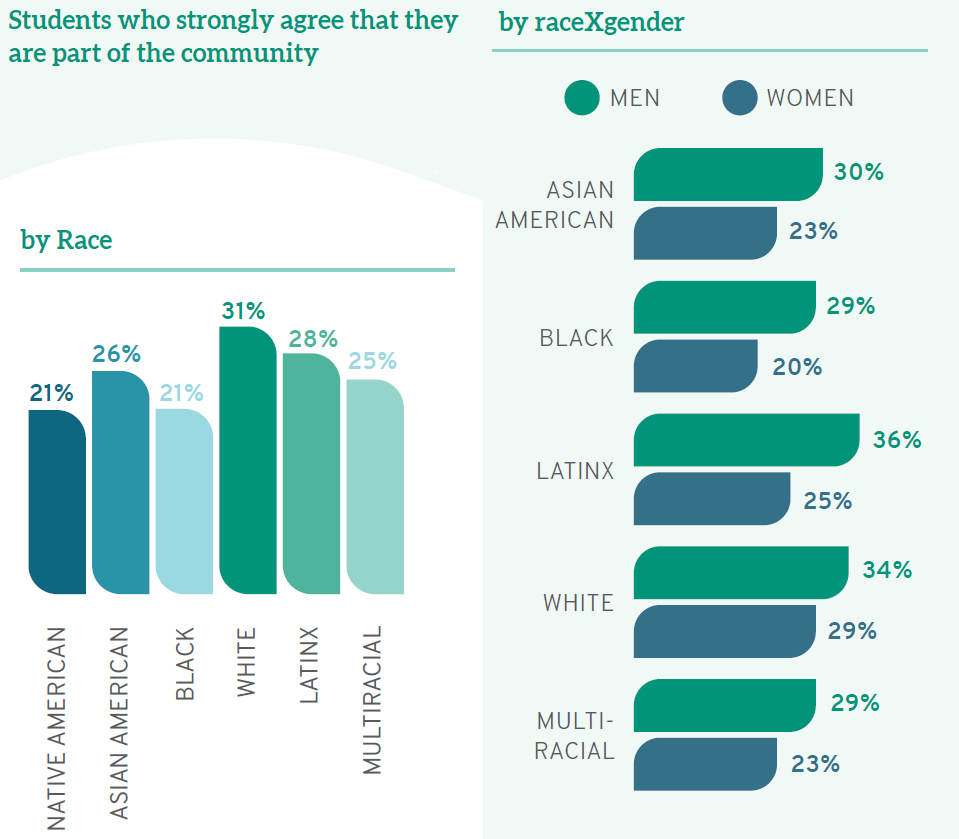
Students of color are also more likely than their White classmates to think their schools do "very little" to ensure students are not stigmatized based on various identity characteristics, including race/ethnicity, gender, religion, and sexual orientation. While only 9.3% of White students agree, 14% of Native Americans, 18% of Latinx students, and a full quarter (25%) of Black students believe their schools do "very little" to emphasize that students are not stigmatized based on identity. Similarly, 11% of heterosexual students think their schools do only "very little" to avoid identity-based stigma; conversely, 20% of gay students, 16% of lesbians, 15% of bisexual students, and 19% of those who identify as another sexual orientation see their schools as doing "very little" in this regard. Taken together, these findings suggest that those most likely to suffer stigma are also those most likely to think their schools do very little to protect them.
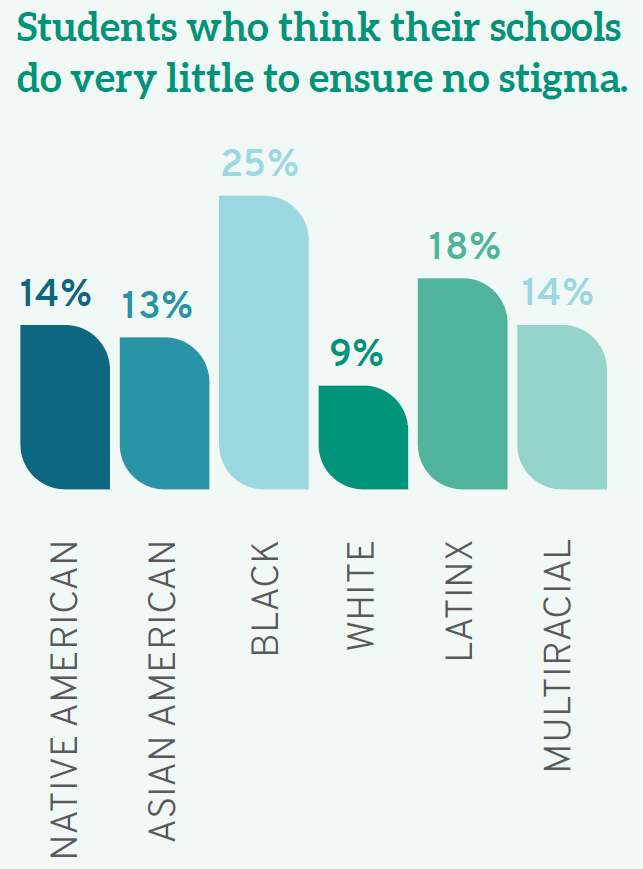
White students are also more likely than those from other backgrounds to be comfortable being themselves on campus, with only 12% noting they are not. Yet one out of every five (21%) law students who is Native American, Black, or Latinx notes that they do not "feel comfortable being myself at this institution."
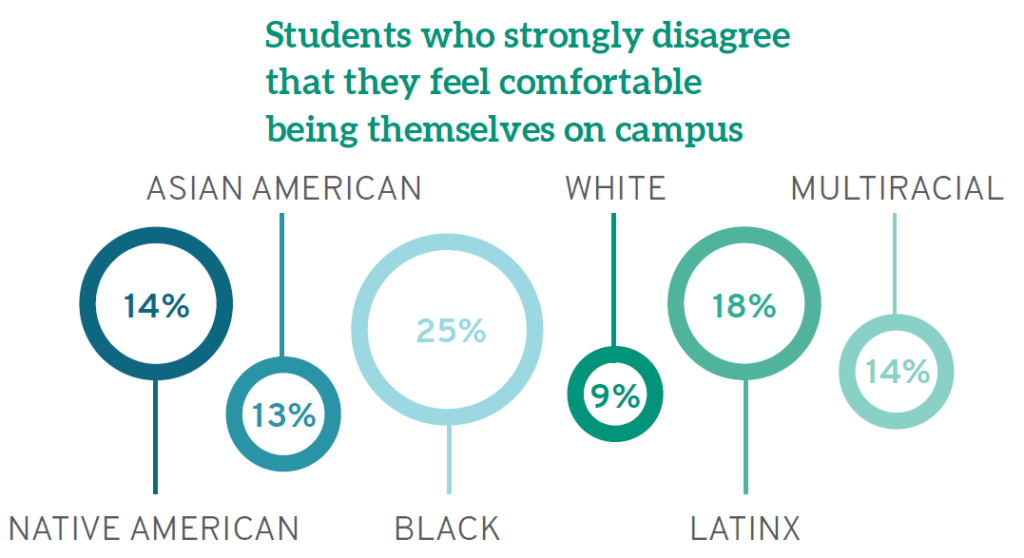
There are also disturbing disparities when considering parental education—a strong proxy for family socioeconomic status. Being comfortable on campus increases almost in lockstep with increases in parental education; a full 32% of law students whose parents did not finish high school are uncomfortable being themselves on campus, compared to just 12% of those who have a parent with a doctoral or professional degree.
The overarching theme from this report is that those who are most affected by policies involving diversity—the very students who are underrepresented, marginalized, and non-traditional participants in legal education—are the least satisfied with diversity efforts on campuses nationwide. Nontraditional students remain marginalized on campus, left out of the community, devalued, and underappreciated. The solution is clear: institutions should place greater emphasis on valuing students from all backgrounds, creating an inclusive community, and integrating diversity into the curriculum. With that foundation, law schools can prepare students to interact in meaningful ways with diverse clientele, to first recognize and then resist instances of discrimination or harassment, and to meet the many challenges they will confront in their roles as lawyers and leaders.
1 Kuh, G. D., Kinzie, J., Buckley, J. A., Bridges, B. K., & Hayek, J. C. (2006). What matters to student success: A review of the literature (ASHE Higher Education Report). San Francisco, CA: Jossey-Bass.
2 Strayhorn, T. L. (2018). College students’ sense of belonging: A key to educational success for all students. New York, NY: Routledge.
Annual Results 2020 Diversity & Exclusion: Institutional Support for Diversity
This year for the first time, LSSSE introduced a set of questions focused on diversity and inclusion that supplement related questions from the primary survey. The Diversity and Inclusiveness Module examines environments, processes, and activities that reflect the engagement and validation of cultural diversity and promote greater understanding of societal differences. The 2020 LSSSE Annual Results Diversity & Exclusion report presents data about how diversity in law school can prepare students for the effective practice of law upon graduation. In our next three posts, we will highlight key findings from the report and suggest some areas for improvement.
Support for diversity in law school must begin with the institution. Yet many students of color do not see their campus as supportive of racial/ethnic differences. Almost a quarter (23%) of Black law students nationwide say their schools do "very little" to create a supportive environment for race/ethnicity, compared to just 6.8% of White students. At the opposite end of the spectrum, 32% of White students believe their schools do "very much" to support racial/ethnic diversity, compared to only 18% of their Black classmates. Men (37%) are also more likely than women (26%) and those of another gender identity (7.5%) to believe their campus is very supportive of racial/ethnic diversity. Even more dramatic are intersectional identity findings, as a full 26% of Black women— more than any other raceXgender group—see their schools doing "very little" to create an environment that is supportive of different racial/ethnic identities, as compared to just 5.5% of White men (while 72% of White men believe their schools do "quite a bit" or "very much" in this arena).
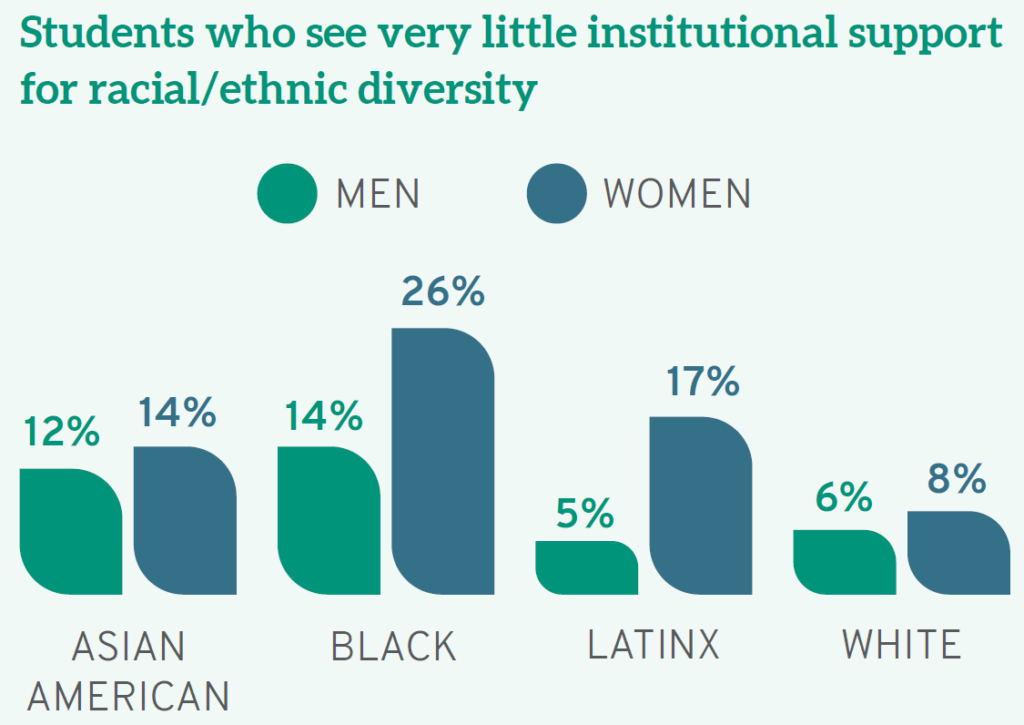
Men are also more likely to see their campus as a "supportive environment for gender diversity," with 39% believing this "very much" as opposed to 27% of women students, and only 9% of students who identify as another gender identity. Furthermore, White students as a whole (33%) see the campus as very supportive of people of different genders, compared to 21% of Native Americans and Black students. Again, the views of White male students differ significantly from most others with a full 40% seeing their campus as very supportive of gender difference. In short, women as well as others from less privileged groups do not see their schools as particularly supportive of gender inclusivity.
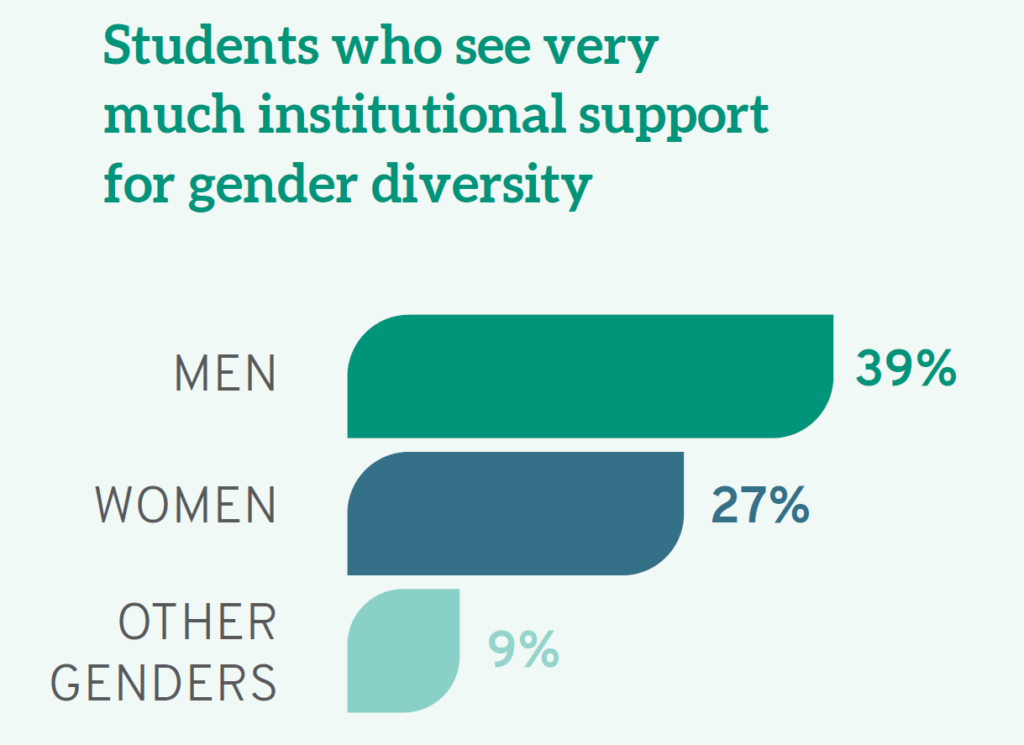
Not surprisingly, given the relative lack of support they see for racial/ethnic and gender diversity on campus, women and students of color also believe their schools are less invested in them as individuals. When asked whether they "feel valued" by their law school, a full 30% of men "strongly agree" compared to only 24% of women and 21% of those who identify as neither male or female. Similarly, the racial/ethnic group most likely to "strongly agree" is Whites (28%). In fact, while Latinos, White men, and Black men "strongly agree" that they are valued at roughly equal rates, men feeling more valued than women is consistent across every racial/ethnic group. Furthermore, students who are the first in their families to earn a college degree, often called "first-gen" students, feel less valued by their institution: a full third (33%) note they do not feel valued, compared to a quarter (25%) of others, which is also a significant proportion of law students overall.
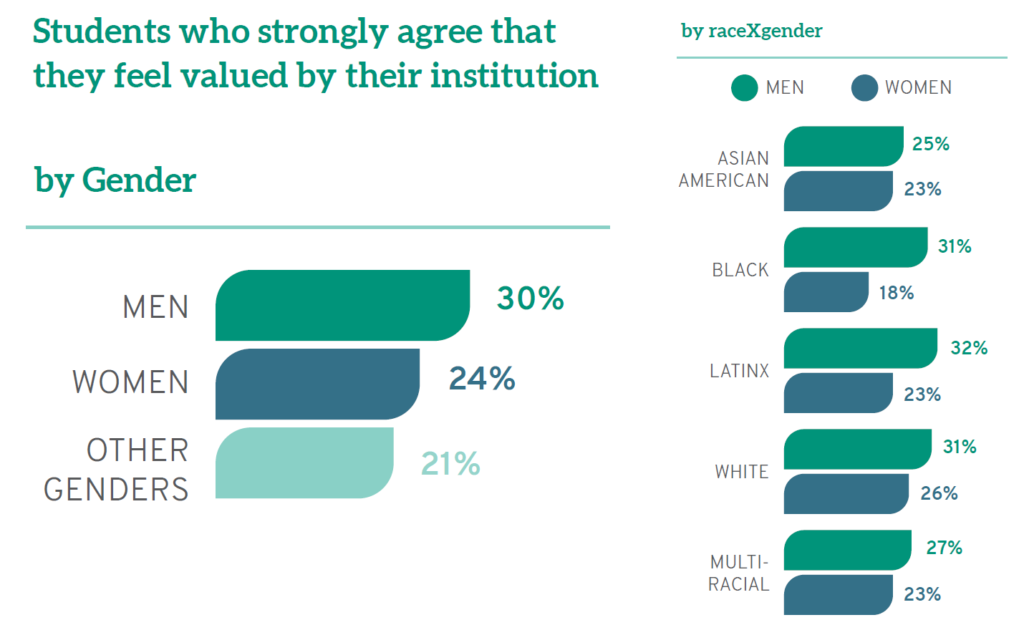
Institutions can put mechanisms in place to foster community among those on campus, regardless of their background or experiences. Finding this common ground helps all students understand that they belong and that others who may be different should be equally welcome. Again, White students are most likely to believe their institution emphasizes the importance of "creating an overall sense of community among students." While 28% of White students think their schools do this "very much," smaller percentages of students of color feel similarly. Even more disheartening, 18% of Black students and 14% of Latinx students think their schools do "very little" to foster community.
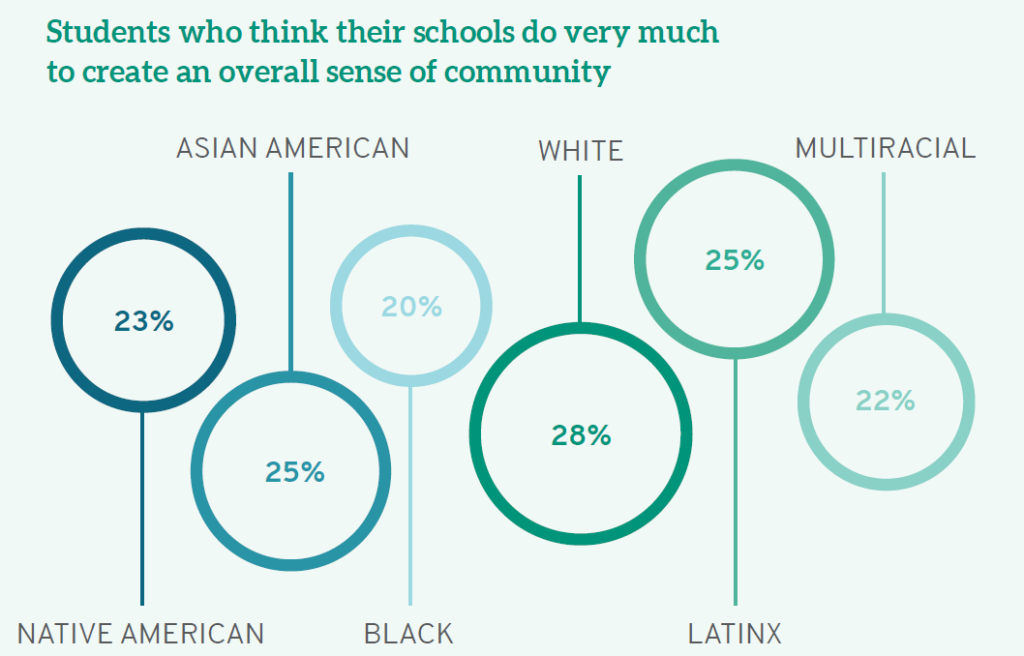
Many law schools have made concerted efforts to add student diversity to their campuses. But once students enroll, we owe it to them to provide a safe and welcoming environment, one where they feel valued, where they can be themselves, where they acquire the tools they need to succeed in the workplace, and where they can thrive. Admitting and even enrolling more students of color, first-gen students, students who identify as LGBTQ, and women is not enough unless that diversity is accompanied by inclusion. Law schools that want their students to succeed as future lawyers and leaders must commit to fostering a campus community where the most vulnerable and non-traditional are encouraged to reach their full potential, where faculty are expected to train students not only for the global marketplace but for the realities of American life, and where all students appreciate their own backgrounds, biases, and responsibilities to the profession.
Where do students get advice?
LSSSE’s optional Student Services module asks students about whether and how often they access academic and career services. Students draw from various sources to get advice about law school, legal education, and their future careers. Here, we look at the most commonly selected meaningful sources of advice for students and examine how patterns of advice-seeking change as students progress through law school.
Advice about Academic Plans
Faculty or staff not formally assigned as an academic advisor are the most common meaningful source of advice about academic planning. Over 40% of LSSSE respondents rely on these personal relationships that they develop with the law school professionals around them. Formal academic advisors –those assigned and those available to any students – are the second and third most commonly used sources of advice and were selected by 26% and 23% of students, respectively. About 22% of students consider websites, catalogs, or other published sources to be meaningful sources of advice about academic plans, and roughly one in five consulted family members. Only 14% of respondents did not seek academic advice from anyone during the current school year.
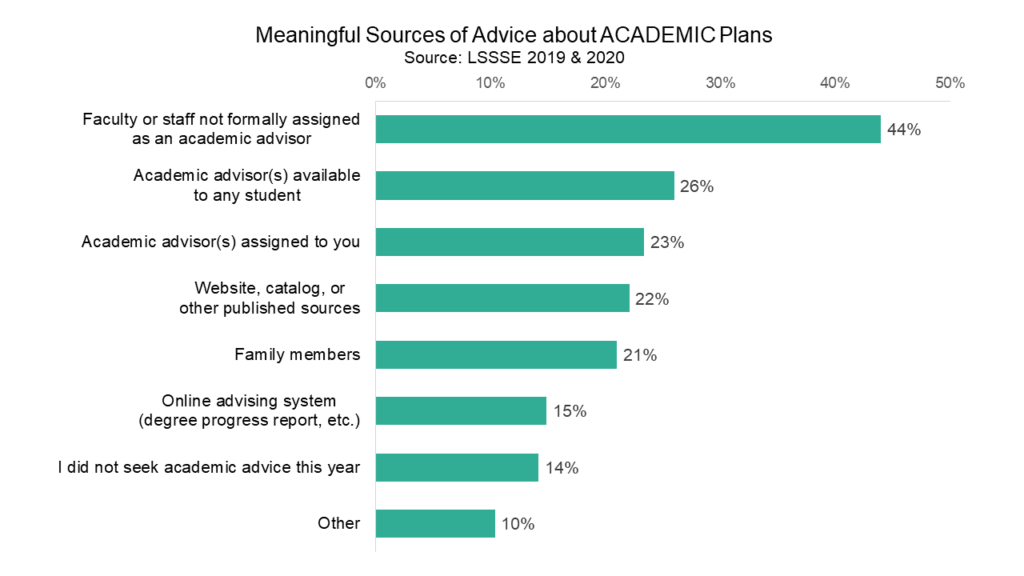
Students appear to rely less on assigned academic advisors as they progress through law school. Roughly one-third of 1L students say their assigned academic advisor was a meaningful source of advice, but only 15% of 3L students feel the same way. Perhaps unsurprisingly, 3L students were slightly less likely to seek academic advice than 1L and 2L students.
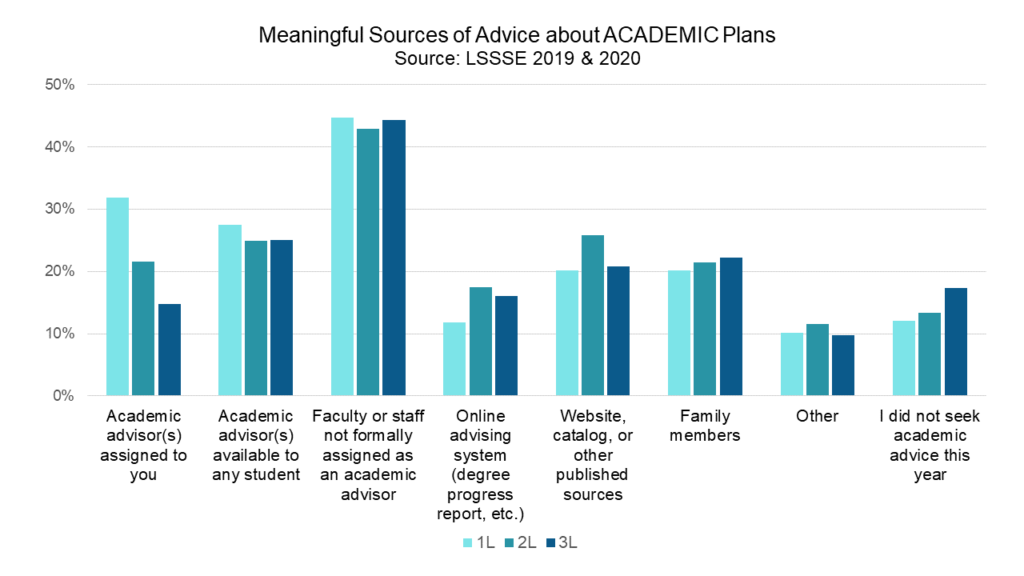
Advice about Career Plans
The ranking of meaningful sources of advice about career planning is remarkably similar to the ranking for advice about academic planning. Students highly value their relationships with law school faculty and staff when it comes to seeking career advice, ranking faculty or staff not formally assigned as a career advisor highest (38%), followed by career advisors available to any student (35%) and then assigned career advisors (27%). Interestingly, students were equally likely to select family members and assigned career advisors as meaningful sources of career advice. Twelve percent of respondents did not seek any career advice during the current school year.
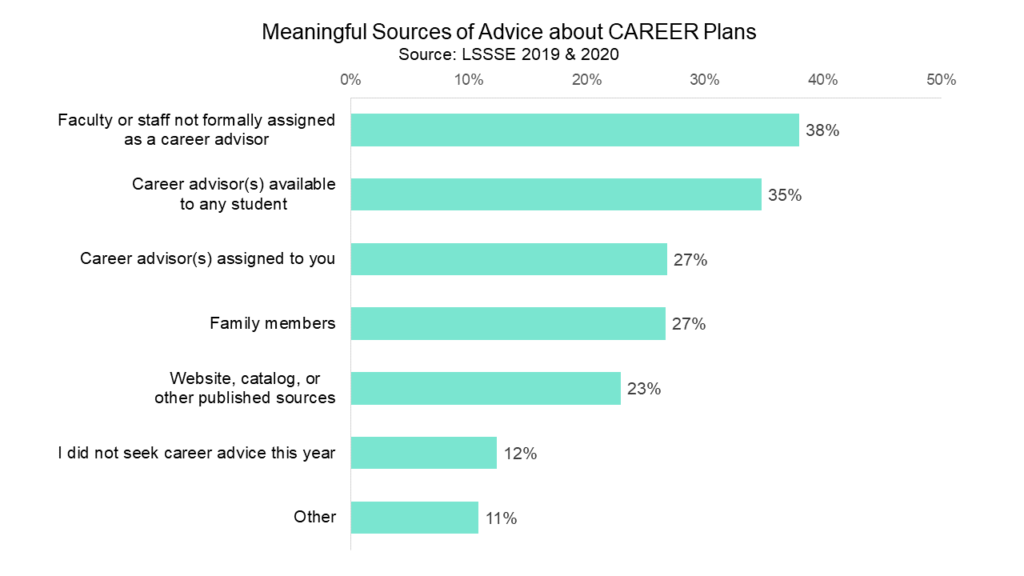
Students rely less on assigned career advisors as they progress through law school, which is similar to the pattern we saw for academic advising. However, the gradual decrease in reliance on formal career advising is somewhat mirrored by a gradual increase in reliance on advice from faculty or staff not formally assigned as career advisors. It would appear that as students refine their interests and form relationships with particular faculty or staff members, they start to rely more on personal relationships for career advising and less on relationships facilitated by the structure of law school.
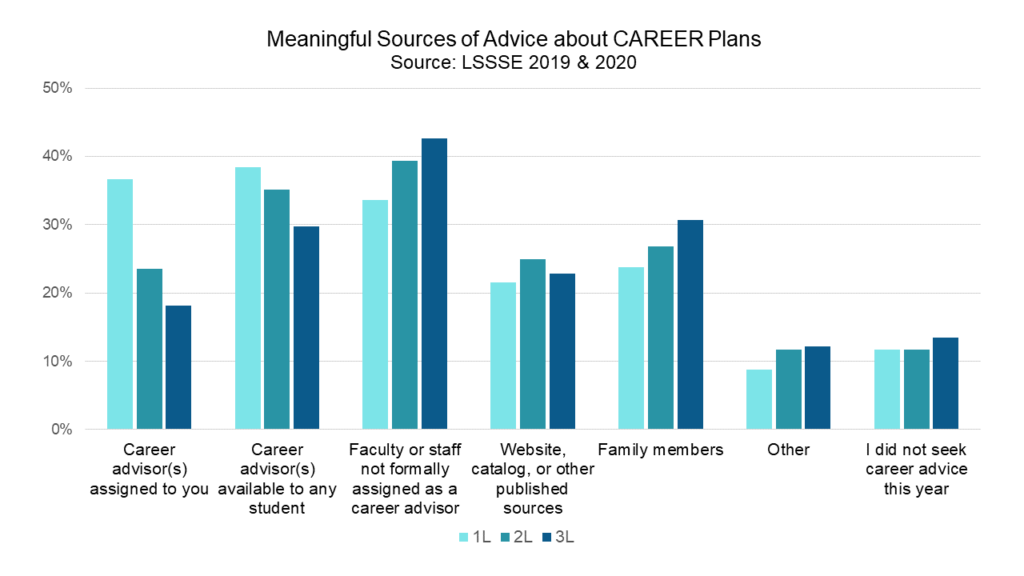
Learning How to Think Like a Lawyer
A legal education strives to teach law students how to "think like a lawyer." Although students may not articulate their reasons for attending law school in exactly this way, the rigor of the law school curriculum certainly challenges students to develop mental flexibility and analytical critical thinking skills. LSSSE asks students to comment on the degree to which their coursework emphasizes the development of several mental activities, namely memorizing, analyzing, synthesizing, making judgments, and applying ideas to new situations.
For each skill, more than half of law students indicated that their school emphasized developing that skill "quite a bit" or "very much." Analyzing the basic elements of an idea, experience, or theory was a nearly universal skill with ninety percent of 2020 LSSSE respondents reporting high emphasis in their coursework. Nearly as many (85%) said their law school placed a high emphasis on applying theories or concepts to new situations. About 83% felt that their coursework emphasized synthesizing ideas into new interpretations, and about 74% said the same for making judgments about the value of information. Memorization was the least emphasized mental activity, but still, 61% reported that their coursework places a high emphasis on memorizing facts, ideas, or methods.
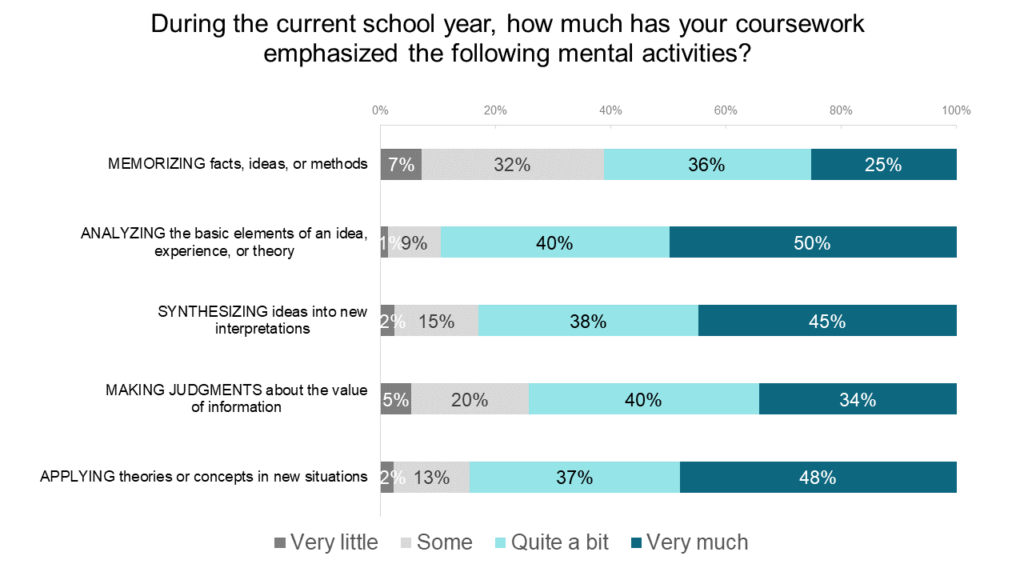
1L students were slightly more likely than 3L students to say that their coursework emphasized the development of any given mental activity. This may be because 1L students are still in the process of adjusting to the rigors of a legal education and thus are more likely to see their educational challenges as formidable. It may also reflect the slight gradual decline in satisfaction and enthusiasm that occurs as law students progress through their degree programs.
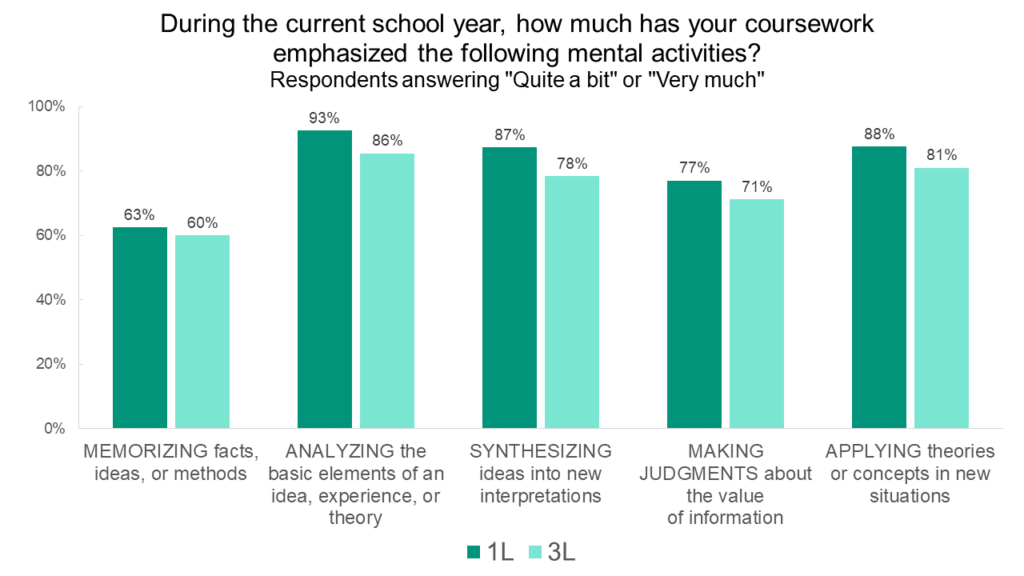
Interestingly, the ranking of the five mental activities has remained constant since at least 2005. The longitudinal LSSSE data show a slight increase in the proportion of students who report that their schools place a high emphasis on each mental activity from 2005 to 2015 and then a slight decrease or plateau for each activity from 2015 to 2020.
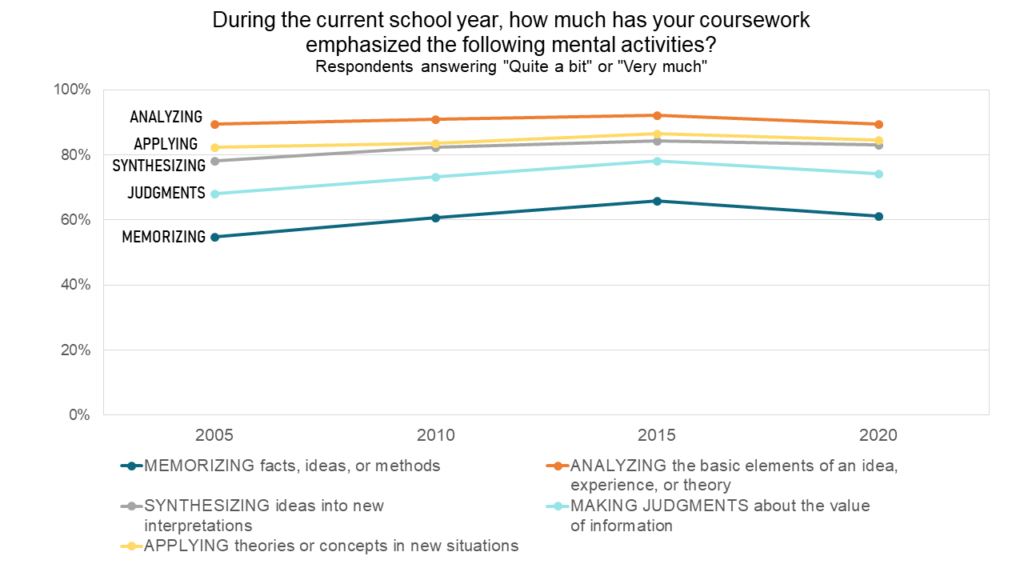
Clearly, law school remains a challenging endeavor in that it places a strong emphasis on developing higher order mental faculties including analyzing the basic elements of an idea, experience, or theory, applying theories or concepts to new situations, and synthesizing ideas into new interpretations. Only a tiny percentage of students report that their legal education has placed very little emphasis on any of these skills. This suggests that law school is delivering on the promise to teach students how to think like a lawyer.
Guest Post: Issue (Blind)Spotting: Using Data to Understand Candidate Motivations to Attend Law School
Guest Post: Issue (Blind)Spotting: Using Data to Understand Candidate Motivations to Attend Law School
 Kristin Theis-Alvarez
Kristin Theis-Alvarez
Dean of Admissions and Financial Aid
Berkeley Law
Law school trains students to “issue-spot.” This means faculty test whether students can apply general knowledge to novel situations. The approach mimics the day-to-day practice of law: a client walks through the front door and you weave together their particular issue with your understanding of the applicable law in general. This isn’t unlike what admissions office representatives do when presenting to or advising prospective applicants. I’ve been in law school admissions since 2007, and have communicated with countless candidates, read thousands of applications, and partnered with a wide range of organizations that seek to increase access to legal education – so I have some sense of what applicants are asking. Against that backdrop (what admissions professionals believe is generally true about people interested in law school), our role is to offer advice based on specific candidate concerns. Where do we gain that broader understanding? LSSSE survey data is a good place to start if we want to move beyond anecdotal evidence. It can inform our understanding of candidate motivations for pursuing a law degree which then refines our outreach and recruitment messaging.
For example, through LSSSE data we learn that most students cite a desire to have a challenging and rewarding career as the most influential factor in their decision to enter law school. Over three-quarters of respondents indicated this was their primary motivation for seeking a law degree. So, it’s reasonable to suppose that when speaking to a room of prospective applicants, admissions professionals ought to emphasize career opportunities and employment outcomes. We might focus that message to highlight our school’s unique attributes (placing more emphasis on the percentage of our graduates working in public interest law or the number with federal clerkships, for example), but we’re always speaking to that core motivation.
Another significant motivator for law school attendance is the extent to which earning a law degree can lead not just to a rewarding career, but a lucrative one. LSSSE data tell us that many law students are pursuing the degree based on a desire to work toward greater financial stability. Taken together, the ability to get a job – and for that job to be one that provides financial stability – largely informs the decision to attend law school. This leads admissions professionals to frequently reference our school’s median starting salaries, and partially explains why we emphasize a ‘return on investment’ model to justify the cost of the degree.
LSSSE data also suggest that a desire to further one’s own personal academic development is a significant motivator for law school attendance. As a result, admissions professionals might emphasize our school’s leading programs, commitment to experiential education, research centers, and interdisciplinary education opportunities. We explain that law school is one of the few graduate programs where the strong possibility of professional and financial success intersects with that of individual growth. (More people might pursue a PhD in Classics if the academic job market looked different, and we might have fewer law students if instead of teaching through the casebook method we just handed everyone a list of rules to memorize.) We balance employment statistics with anecdotes about student skills being developed and deployed.
At the same time, less than half of LSSSE respondents report that an “inherent interest” in the curriculum or material they are learning is a source of motivation for them to work hard in law school. This may be why most law admissions professionals are not talking to eager undergraduate students about provisional remedies. It’s also why we generally explain a legal education as the opportunity to develop a diverse toolkit that can be used to solve complex problems, and not merely a content delivery method. Instead, more than half of respondents cite being competitive in the job market as a primary motivation to work hard in law school.
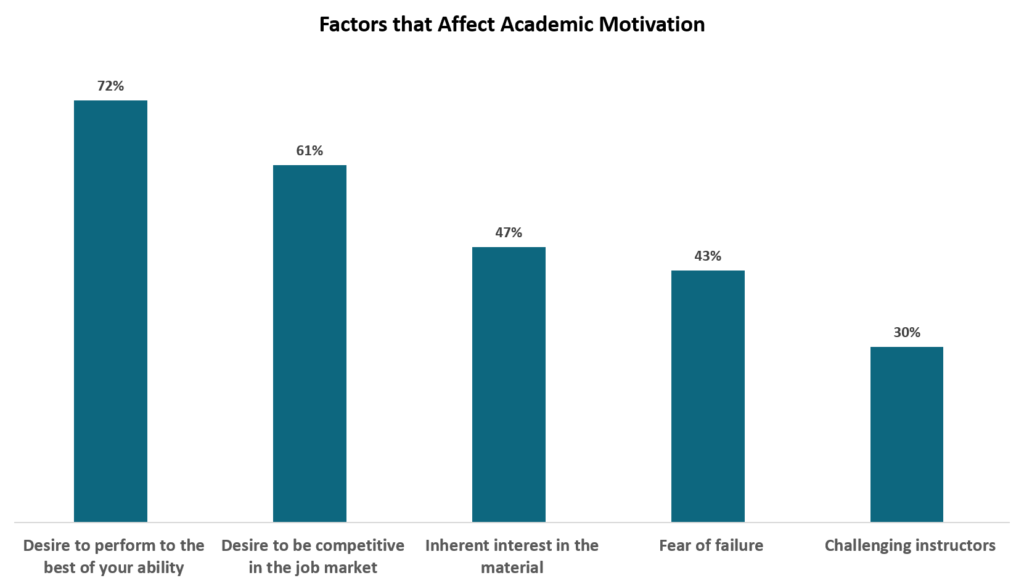
However, there are assumptions that admissions professionals might make when deploying student experience data in our work. Are we asking who we mean when we say “law students,” and who we imagine when we picture “prospective applicants”? More importantly, how do those assumptions lead to missed opportunities to reach candidates from backgrounds underrepresented in the applicant pool?
One way to illustrate this is to examine the differences between general LSSSE data about motivations for attending law school and what we know about the motivations for particular groups. Within the National Native American Bar Association (NNABA) Report “The Pursuit of Inclusion: An In-Depth Exploration of the Experiences and Perspectives of Native American Attorneys in the Legal Profession,” there is a section on the pipeline to law school and the legal profession with a forward written by Stacy Leeds, Dean Emeritus and Professor of Law at the University of Arkansas. This section of the NNABA Report indicates that Native American attorneys were more motivated to enter law school in order to give back to their tribe or Nation, to fight for justice for Indians, and to fight for the betterment of Native peoples’ lives, and less motivated by personal or financial benefit. The data suggest that Native American attorneys’ motivation for attending law school is more connected to identity and heritage, and less tied to individual benefit. According to the NNABA Report, “The difference in why many Native Americans may go to law school is fundamental to understanding how to inspire and motivate more Native Americans to consider law school and the legal profession.” Therefore, not talking to Native American candidates about how to leverage a legal education to serve Native peoples is a missed opportunity to build or fortify interest in the degree.
LSSSE survey data can and should inform a law school admissions office’s outreach and recruitment efforts, but aggregate data can’t be the end of the inquiry. Even within LSSSE data lies the opportunity to further disaggregate, dig deeper, and challenge our assumptions. Admissions professional making use of quantitative data must intentionally work to avoid participation in, or replication of, what Professor Victoria Sutton termed the “paper genocide” of Native American students. And as the NNABA data demonstrates, it’s not safe to assume that what’s true for most is true, or even relevant, for all. Furthermore, the 2020 LSSSE Annual Report “Diversity & Exclusion” shows that the contours of these distinctions persist during (and may even be amplified by) the law school experience itself. Law admissions professionals should therefore question our assumptions about the audiences we speak to, and the students we speak about. Like good lawyers, we must hold general information in the back of our minds, but also listen carefully, research meticulously, and make adjustments. Spotting that issue will not only make admissions professionals more effective, it will ultimately contribute to a more diverse legal profession.
